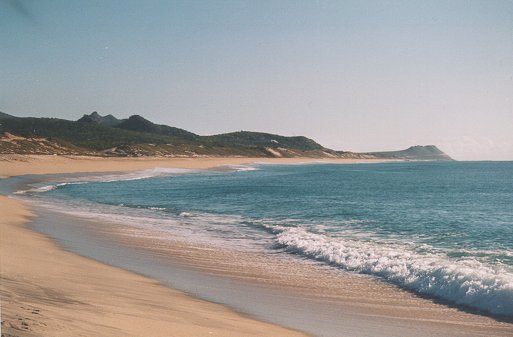Enjoying Baja's two main bodies of water, the Pacific Ocean and the Sea of Cortez, is usually a big part of any Baja getaway. Many of Baja's activities involve being on or in the ocean, including swimming, fishing, snorkeling, diving, surfing, windsurfing, kite boarding, clam digging, kayaking, sailing or just wading into the water for a refreshing dip.
The good news is that most of the interactions that tourists have in Baja's waters are safe and very pleasurable. But even though the odds are against having any kind of problem in the water, being aware of the potential dangers is a good way to keep safe.
In his quest to explore Baja's waters, Carlos Fiesta has had one-on-one encounters with all of the water dangers listed below, with the exception of sharks. Most of these events are not life threatening, usually not unbearably painful, and they make great stories when you get home.
BAJA OCEAN DANGERS

Great beaches and warm waters are two of the main reasons many visitors go to Baja!
JELLYFISH
Jellyfish can be found on both coasts of Baja, although usually not in great numbers on either coast. The larger jellyfish, often up to one foot or more in diameter, can be found occasionally along the west coast of Baja. They are usually found offshore, but can sometimes be found in the surf line as well.
The sting of a large jellyfish can cause significant pain, but the pain is usually temporary and rarely lasts more than a day or two. Since they are relatively easy to see in the water, jellyfish can usually be avoided.
Much smaller jellyfish can be found in the Sea of Cortez. Some of these animals are so small they can barely be seen. In the case of most of these very small jellyfish, the sting is almost unperceptable and causes not much more than an itching sensation in most people.
These very small jellyfish can usually be seen with a mask and snorkel. Since most people snorkeling tend to look down towards the floor of the ocean when snorkeling, it is important to remember to look horizontally when checking for small jellyfish.
It is a good idea to look for evidence of jellyfish while walking along the shore before going into the ocean. If the jellyfish are 'running' there are usually pieces of jellyfish or whole jellyfish laying on the sand between the low tide line and the high tide line.
If there is evidence of jellyfish along the shore there is a very good chance that they will also be in the water. Whether or not jellyfish can be seen on the shoreline, it's always a good idea to keep a look out for these slimy looking creatures once you have entered the water.
STINGRAYS
Stingrays are diamond shaped animals with flat bodies found in ocean waters on both the Pacific Coast of Baja as well as the Sea of Cortez side, usually in shallow warm waters with sandy bottoms. They tend to be more prevelent on the Sea of Cortez side of Baja, and usually hang out together in groups. The larger rays tend to stay in deeper water.
Most swimmers use the 'Stingray Shuffle' as the primary method of avoiding these marine animals. By simply shuffling your feet while walking forward in the water, most stingrays will do their best to get out of the way. Walking 'heavy' on the ocean bottom while shuffling provides the same desired effect...warning these critters that you are nearby.
Stingrays are brown or tan and tend to blend in with flat sandy bottoms. They are sometimes covered with sand, and will usually not spend much time in the surf zone where waves are breaking and where the sandy bottom is rolling from the constant wave action. However, in calmer water just a little bit deeper they can be found laying still on the bottom.
Stingrays have barbed spines near the base of their their long whip-like tails capable of inflicting wounds on whatever part of the 'target' they strike. Since most people surprise stingrays with their feet, foot injuries are by far the most common with stingrays.
Once the barb of a stingray has been 'stung' into the foot of a person, venom enters the bloodstream. The pain is sharp and immediate, varying with the degree of the stingray 'hit'. It is important to address the wound as soon as possible. The main goals are to remove any barb that may have been placed by the ray, and suck out the venum from the wound. This is easily done with a small suction kit available for just such a job. Keeping the affected foot in extremely hot fresh water will do wonders to reduce pain until the poison is removed.
The good news is that stingrays are passive animals. They will only strike when they feel that their life is in danger. Such is the case when most people step on them. So whenever enjoying sandy waters that have been known to contain stingrays, walk slowly and heavily, shuffle your feet and keep your eyes open.
URCHINS
Urchins are very common on the west coast of Baja where the ocean waters are cooler, although there are plenty of urchins in the Sea of Cortez as well. Their habitat usually starts just a foot or two below the ocean surface.
These purple spiney creatures are only found along shorelines that are made up of rocks or reefs. Urchins to not live in or even visit sandy beaches but may proliferate very close by on large submerged rocks adjacent to sandy beaches.
Urchins are usually not much bigger than a human fist, and many of them are smaller. They have hundreds of spiney (extremely sharp) pricks that protrude several inches from the center of their body in all directions.
Once a person had been stuck by an urchin it is important to determine if a part of the urchin needle is still inside the flesh of the victim. If the needle has entered the skin but not broken off inside, the wound will quickly heal and it's Margarita Time.
If the needle of the urchin has broken off inside the person, removing it from the body is the best way to minimize pain and infection. Unlike a stingray wound, there is no real urgency to remove the needle of an urchin, it just makes sense to do it as soon as possible.
Urchin pricks that have broken off inside a person's foot or hand will not desolve in the body quickly. It usually takes months for the human body to desolve the hard needles of an urchin. So if it is possible to remove the needle with a pair of tweezers that should be the goal. Sometimes the urchin needle will 'work its way out' by itself after about two weeks.
CORAL
Coral, the colorful creature that ads so much beauty to the underwater environment, is actually a collection of thousands of small microbic animals joined together, and not an underwater plant as it sometimes appears.
Coral needs an ocean water temperature of at least 70 degrees to live and thrive, which means most of the west coast of Baja does not have coral. Since the south end of the Baja Peninsula is located in the Tropics where the water is warmer year round, coral is common at the Cape from Cabo San Lucas and up into the southern Sea of Cortez.
As beautiful as coral is to look at, you don't want to rub up along side of it when you are next to it. When in contact with human skin, most corals will cause a significant rash, and the rash can become inflamed. The pain is significant, but not unbearable. It usually subsides within 24 hours.
Just like urchins, coral is found on rocks and reefs, and is not found along sandy beaches. Coral thrives on ocean water with nutrients, so water with some degree of circulation tends to be a better invironment for most corals to live long and prosper.
In some parts of the world where the ocean waters are very warm all year long coral grows so well that it actually forms coral reefs systems. In Baja and at the Cape, where waters can get warm but them cool off in winter to around 70 degrees, coral usually forms on existing strata such as underwater rocks and reefs, looking much the same as a real live coral reef.
Probably the best example of coral in Baja is at Cabo Pulmo, just up the East Cape from Cabo San Lucas. The coral at Cabo Pulmo has actually attached itself to an existing rock reef structure, and is a great place to snorkel or dive.
SHARKS
Bad news, good news. The bad news in that there are sharks in the waters off of Baja. The good news? Carlos Fiesta has been swimming, surfing, snorkeling, Scuba diving, kayaking, boating and flying over Baja's oceans for over 25 years and has never seen a single shark.
Sharks live in the ocean and Baja is surrounded by oceans, so it makes sense that somewhere in those waters there are sharks swimming around. But these beautiful animals don't have much interest in the shallow waters near Baja's coastline, so they are really a non-factor for Baja visitors.
There are islands located well off of Baja's coast where large sharks congregate. In fact, there are so many sharks off of some of these islands that dive groups actually arrange tours to these islands so people can 'dive with the sharks'.
Just in case you find yourself in the vicinity of a shark, don't freak out. Most sharks are relatively small and will leave you alone. As for larger sharks, stay calm, don't make any sudden moves, and if the big guy tries to take a bite out of you just punch him on the nose. Really.
Most sharks have no desire to take a bite out of a human being. Incidents where sharks have taken a bite out of people are often explained by the fact that the diver/surfer/swimmer was wearing a wetsuit, looked a bit like a seal (a tastey morsel for any shark!), and made movements that reinforced the idea that the leg/arm/torso in question might indeed be a seal.
In short, you/ve got a much greater chance of getting hurt in your car on the way to the airport than you do of having a close encounter with a ahark in Baja.

Sharks like people...especially little people. (just kidding!)

